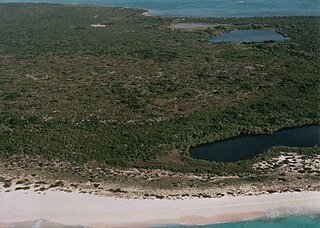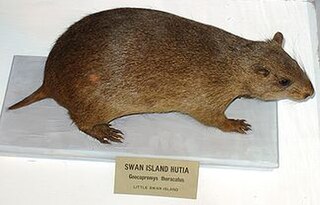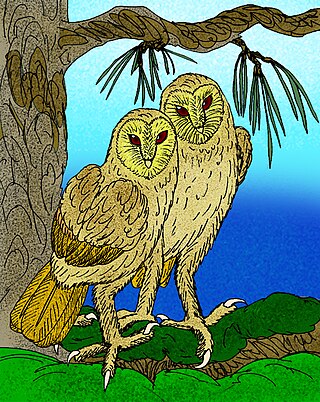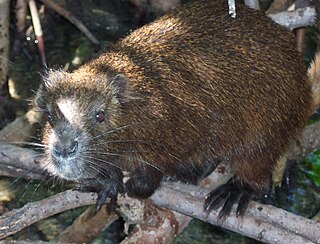
Acklins is an island and district of the Bahamas.

The Plana Cays are a group of two small uninhabited islands in the southern Bahama Islands, located east of Acklins Island and west of Mayaguana Island. The indigenous Lucayan people called the islands Amaguaya, meaning "toward the middle lands".

The Little Swan Island hutia is an extinct species of rodent that lived on Little Swan Island, off northeastern Honduras in the Caribbean. It was a slow-moving, guinea-pig-like rodent and probably emerged from caves and limestone crevices to forage on bark, small twigs and leaves.

Hutias are moderately large cavy-like rodents of the subfamily Capromyinae that inhabit the Caribbean islands. Most species are restricted to Cuba, but species are known from all of the Greater Antilles, as well as The Bahamas and (formerly) Little Swan Island off of Honduras.
Garrido's hutia is a small, critically endangered, rat-like mammal found in coastal mangrove forests on Cuba and nearby islands. It is rarely seen and may be extinct. It is a member of the hutia subfamily (Capromyinae), a group of rodents native to the Caribbean that are mostly endangered or extinct. The only other species in its genus, the Desmarest's hutia, is also found only on Cuba.

Geocapromys is a genus of rodent belonging to the hutia subfamily and are currently only found on the Bahamas and Jamaica. However, they formerly ranged throughout the Caribbean, from Cuba to the Cayman Islands to even islands off mainland Central America.

The Jamaican coney, also known as the Jamaican hutia or Brown's hutia, is a small, endangered, rat-like mammal found only on the island of Jamaica. About the size of a rabbit, it lives in group nests and is active at night to feed on fruit, bark, and other plant matter. It is currently endangered by habitat loss, hunting, and non-native species; it persists only in remote mountains. The Jamaican coney belongs to the hutia subfamily (Capromyinae) and is the only surviving native mammal on Jamaica other than bats.

Tyto pollens is an extinct giant barn owl which lived in the Bahamas during the last Ice Age.

Desmarest's hutia or the Cuban hutia is a stout, furry, rat-like mammal found only on Cuba and nearby islands. Growing to about 60 cm (2 ft), it normally lives in pairs and feeds on leaves, fruit, bark and sometimes small animals. It is the largest living hutia, a group of rodents native to the Caribbean that are mostly endangered or extinct. Desmarest's hutia remains widespread throughout its range, though one subspecies native to the nearby Cayman Islands went extinct shortly after European colonization in the 1500s.
The Cuban coney is an extinct species of rodent in the subfamily Capromyinae. It was endemic to Cuba. Its natural habitats were lowlands moist forests, xeric shrublands and rocky areas. Some scientists indicate that this species may have survived and coexisted with introduced rat species from the Old World until approximately 1500, while others indicate that it became extinct earlier in the Holocene.

The prehensile-tailed hutia is a small, furry, rat-like mammal found only in forests on Cuba. It is the only member of the genus Mysateles. It climbs and lives in trees where it eats only leaves, and it is threatened by habitat loss. The prehensile-tailed hutia is a member of the hutia subfamily (Capromyinae), a group of rodents native to the Caribbean that are mostly endangered or extinct.

Cyclura cychlura inornata, the Allen Cays rock iguana or Allen Cays iguana, is a subspecies of the northern Bahamian rock iguana that is found on Allen's Cay and adjacent islands in the Bahamas. Its status in the IUCN Red List is critically endangered. The population has been growing over the last century. Although it was considered extinct in 1916, there are as of 2018 at least 482 mature adult animals counted on two islands, Leaf Cay and U Cay, and a few hundred on at least five other nearby islands where they have recently spread to by unknown means, as well as many juveniles.
The Caribbean bioregion is a biogeographic region that includes the islands of the Caribbean Sea and nearby Atlantic islands, which share a fauna, flora and mycobiota distinct from surrounding bioregions.

Cyclura cychlura figginsi, known by the common name of guana and sometimes called the Exuma Island iguana in the international literature, is a subspecies of the northern rock iguana, C. cychlura, that is found on the Exuma island chain in the Bahamas with an estimated wild population of 1,300 animals in 2004, it has been listed on the IUCN Red List as critically endangered.
Leiocephalus greenwayi, commonly known as the East Plana curlytail and the Plana Cay curlytail lizard, is a species of lizard in the family of curly-tailed lizards (Leiocephalidae). The species is native to the West Indies.

The San Felipe hutia, also known as the little earth hutia, is small, critically endangered, rat-like mammal found on the small island of Cayo de Juan Garcia off the southwest coast of Cuba. It was discovered in 1970 and is possibly extinct. Little is known about the species, except that it lives in swamps and coastal mangrove forests. It is a member of the hutia subfamily (Capromyinae), a group of stout rodents native to the Caribbean that are mostly endangered or extinct.
The Bahamian dry forests are a tropical and subtropical dry broadleaf forest ecoregion in the Bahamas and the Turks and Caicos Islands, covering an area of 4,900 km2 (1,900 sq mi). They are found on much of the northern Bahamas, including Andros, Abaco, and Grand Bahama, where they are known as coppices. Dry forests are distributed evenly throughout the Turks and Caicos.

Chilabothrus strigilatus, also known commonly as the Bahamian boa, is a species of snake in the family Boidae. The species is endemic to the Bahamas. There are five recognized subspecies.













